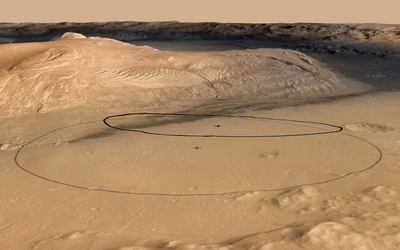NASA News Release:
RELEASE : 12-257
Daring NASA Mars Mission Broadcast Lands In Times Square
July 31, 2012
WASHINGTON -- The Toshiba Vision screen in New York City's Times Square will become the largest East Coast location for the public to see live mission coverage of Curiosity, NASA's most advanced planetary rover, as it lands on the Martian surface at 1:31 a.m. EDT August 6.
The Toshiba Vision screen will broadcast NASA TV coverage beginning at 11:30 p.m. EDT August 5 and continuing through 4 a.m. EDT the next day. Programming will originate from Mission Control at NASA's Jet Propulsion Laboratory's (JPL) in Pasadena, Calif. The rover is on a precise course for a landing beside a Martian mountain to begin 2 years of unprecedented scientific detective work.
"In the city that never sleeps, the historic Times Square will be the place for New Yorkers to participate in this historic landing," said John Grunsfeld, associate administrator for NASA's Science Mission Directorate. "When you think of all the big news events in history, you think of Times Square, and I can think of no better venue to celebrate this news-making event on Mars."
Getting Curiosity to the surface of Mars will not be easy. During a critical period lasting only about 7 minutes, the MSL spacecraft carrying Curiosity must slow down from about 13,200 mph (about 5,900 meters per second) to allow the rover to land on the surface at about 1.7 mph (three-fourths of a meter per second). For the landing to succeed, hundreds of events will need to go right, many with split-second timing. All are controlled autonomously by the spacecraft.
Prominently positioned below the world-famous New Year's Eve ball in Times Square, the Toshiba Vision dual LED screens will allow viewers to see the action from Mission Control, including receipt of the first signal from Mars following a successful landing. "We're pleased the Toshiba Vision screens will offer a unique view of this great scientific achievement, the landing of the rover Curiosity on Mars," says Eddie Temistokle, senior manager of corporate communications and corporate social responsibility for Toshiba America Inc.
Visitors to Times Square can hear the audio portion of NASA's coverage along with other listeners around the world by tuning in to the online radio station Third Rock Radio. This is the first time Third Rock Radio will provide live coverage of a NASA event. Third Rock Radio can be streamed from the NASA homepage at and on smart phones and tablets through the Tuneln mobile app.
In the first several weeks after landing, JPL mission controllers will put the rover through a series of checkouts and activities to characterize its performance on Mars while gradually ramping up scientific investigations. Curiosity then will begin investigating whether an area with a wet history inside Mars' Gale Crater ever has offered an environment favorable for microbial life.
{...}
SPACE.com:
NASA to Broadcast Mars Rover Landing From NYC's Times Square Sunday Night
Discovery News:
Mars Rover Curiosity Makes it to Times Square
Universe Today:




